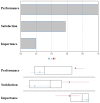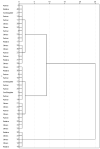Caregivers' Profiles Based on the Canadian Occupational Performance Measure for the Adoption of Assistive Technologies
- PMID: 36236598
- PMCID: PMC9573476
- DOI: 10.3390/s22197500
Caregivers' Profiles Based on the Canadian Occupational Performance Measure for the Adoption of Assistive Technologies
Abstract
The COPM (Canadian Occupational Performance Measure) is a tool that is based on the identification of self-perceived performance and satisfaction problems in the performance of occupations, allowing the creation of a hierarchy in the order of the interventions to be carried out, and speeding up the identification of the necessary AT (Assistive Technologies). Given the importance of the caregiver's perception about their own performance in the design of AT, this research examines the caregiver's profile through the COPM. A sample of 40 caregivers volunteered to participate in the study. A cluster analysis was carried out on the COPM scores. Two caregiver profiles were found in relation to the COPM measure, one with low scores on performance and satisfaction and another with high scores on both of these two variables. The main predictor was found to be the self-perception of performance. The structure was replicated through a hierarchical cluster analysis, where the role of caregivers was of interest. These results are relevant on both a theoretical and practical level.
Keywords: COPM; assistive technology; caregivers; satisfaction.
Conflict of interest statement
The authors declare no conflict of interest.
Figures
References
MeSH terms
Grants and funding
LinkOut - more resources
Full Text Sources
Medical




